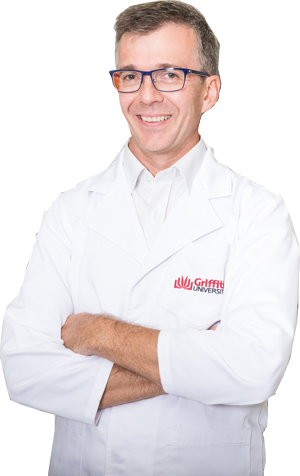Researching treatments for sufferers of acquired brain and spinal cord injuries
A few years ago it was a dream, but there is now evidence that spinal cords can regenerate following severe injuries. That means new hope for an estimated 250,000 to 500,000 people globally who suffer a spinal cord injury. In Australia alone, the lifetime cost of care and lost economic activity for someone with quadriplegia is $9 million and the total current cost to the community for all spinal cord injuries exceeds $2 billion annually. A therapy that gives people back their independence will also save our community enormous costs.
Clem Jones Centre for Neurobiology and Stem Cell Research
A dedicated research hub within GRIDD, the Clem Jones Centre for Neurobiology and Stem Cell Research aims to develop therapies to treat acquired brain and spinal cord injury. Led by Professor James St John, researchers follow an approach that transplants cells from the nose into injured spinal cords to form a cellular bridge, enabling the regeneration of nerve cells to make functional motor and sensory connections. As their work progresses, they never lose sight of the long-term prospect that people suffering quadriplegia or paraplegia may walk and feel again.

The work is founded on the ground-breaking research of Australian of the Year 2017 Professor Emeritus Alan Mackay-Sim, who conducted a clinical trial showing transplantation of these nasal cells into the human spinal cord was possible and safe in people. Among the follow-up research taking place in other countries, in 2014 a Polish-UK team made a major breakthrough by demonstrating successful transplantation and mobility in one person.
Professor St John calls himself a ‘scientist entrepreneur’ who has moved beyond traditional drug discovery to be focused on a cure, and whose team members brings whatever is needed to get results—chemistry, neuroscience, engineering, commercial products and biology.
Queensland Premier Annastacia Palaszcuk opened the Centre in 2016. Centre funders include the Clem Jones Group, Perry Cross Spinal Research Foundation. In 2017, the Queensland Government provided $5 million towards further research.
Next steps
Much work remains to be done to perfect a treatment. The team is aiming to improve the purity and longevity of cells used as potential treatments, and utilise other natural products that may work better. At present, purity is too low, and 99 per cent of cells die within 24 hours of injection.
The team is already looking and planning ahead with the aim of faster-to-market and a more affordable therapy as the final outcome. They know they will need three phases of clinical testing, protection of their intellectual property and that this may be a six-year process, before commercial production is considered safe and viable. There are no guarantees each phase will be successful, yet the optimism and sense of urgency in the team is palpable. The St John group at the Institute is partnering with Griffith Enterprise.
New hope
Professor St John says the team has spoken with those suffering from spinal injuries through the Perry Cross Spinal Research Foundation, one of the Centre’s partners.
‘Several have toured our facilities to see what we’re doing. They want this kind of outcome where they may have a chance of regaining control of their bodies,’ he says. ‘One said to me, your research does not give us false hope, there’s either hope or no hope, and we’d rather have hope!’